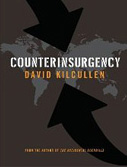Here is the latest edition of
my column at Foreign Policy:
Topics include:
1) Gates lectures the Navy. Next, he should lecture himself.
2) There is no Gulf of Tonkin in Korea.
Gates lectures the Navy. Next, he should lecture himself.
On May 3, U.S. Defense Secretary Robert Gates delivered a stern message to Navy: The branch should not count on a taxpayer bailout to fix its shipbuilding problems. Virtually every recent shipbuilding program has been plagued with mismanagement and alarming cost overruns, resulting in a shrinking fleet and longer and more stressful deployments. Gates's advice to a gathering of naval officers and contractors was that they should break with the traditional and instead entertain some "outside the box" thinking. He assured his audience that there would be no increases in the Navy's procurement budget.
Gates's grim fiscal message for Navy planners comes at what might be an important inflection point in global naval power. There is no question, as Gates noted in his speech, that the U.S. Navy possesses overwhelming superiority. But the trends are not so friendly. While U.S. naval contractors struggle to put new affordable hulls in the water, China's fleet continues to rapidly expand. In recent testimony to the Senate Armed Services Committee, Adm. Robert Willard, commander of Pacific Command, made note of China's preparations for "area denial," a strategy that concentrates anti-ship firepower to deny an adversary's access to a specific part of the ocean. According to Willard, China now has the world's largest conventionally powered attack submarine fleet, continues its testing of long-range, anti-ship, cruise and ballistic missiles, and will launch its first aircraft carrier in two years. During a recent visit to China, two Obama administration officials were told by their Chinese hosts that China would not tolerate any interference in the South China Sea.
In his speech, Gates denounced the Navy's response to the adverse trends Willard described. According to the secretary, the Navy's unimaginative answer is to replace its old warships with newer, more complex, and grossly expensive versions from the same family tree. As the costs of the new ships have exploded, the Navy has been unable to afford one-for-one replacements. The result has been a shrinking Navy and greater stress on the remaining ships and sailors.
Gates called for innovations in the Navy's thinking and design that would bypass the area denial strategy. The first of his suggestions was to greatly increase the Navy's striking range. For example, operating long-range unmanned strike aircraft from aircraft carriers would safely pull the valuable flat tops away of the most dangerous contested waters, negating an adversary's area denial plans. Gates also lauded the new "air-sea battle" concept -- an effort by Navy and Air Force planners to integrate their forces to achieve operating synergy. Such an approach could also provide another technique for bypassing an adversary's area denial strategy.
What is ironic is that Gates himself has stood in the way of his own solutions. While he discussed the need for long-range striking capability, it is Gates who has promoted the short-range F-35 Joint Strike Fighter program for the Air Force, Navy, and Marine Corps. At more than $247 billion, the troubled F-35 is the costliest weapons program in history, but no one has been a stronger defender of the program than Gates. While he has slashed and canceled other programs, Gates's latest budget request defends the full purchase of more than 2,400 F-35s for all three services. With such a commitment to the pricey fighter, commanders will be stuck inside the area denial trap, exactly opposite to the outcome Gates hoped for in his speech. Meanwhile, an Air Force long-range strike drone is languishing inside yet another Gates-ordered research study, and the Navy's long-range carrier-based drone experiment proceeds at a leisurely pace. Under Gates's current budget, neither of these two solutions to the area denial problem will be available for at least a decade.
Gates is right to call for a shake-up in the Navy's thinking. But if he is wondering what is holding up some of his own good ideas, perhaps he should have a talk with himself.
There is no Gulf of Tonkin in Korea
South Korea's President Lee Myung-bak is receiving a quick and painful lesson in the politics of crisis management. On March 26, the South Korean Navy corvette Cheonan exploded, broke in half, and sank in South Korean waters, killing 46 crewmen. South Korea's defense minister, aided in his investigation by U.S. naval intelligence, concluded that a heavy torpedo was the most likely cause of the disaster. Lee has declared the sinking "was no accident." Although he has vowed to take a "clear and resolute measure" against those who sunk the Cheonan, Lee has hesitated to explicitly blame the North Korean government for the attack.
With it well-known throughout South Korea that thousands of North Korean cannons and rockets loom within striking distance of Seoul, Lee is very unlikely to order even token military retaliation. Most South Korean voters will undoubtedly approve of this conclusion; they along with Lee are happy to gamble that North Korea's Kim Jong Il is not deliberately testing the limits of provocation.
With no follow-up action or talk from the North, why did the attack occur? One reason might be that a rogue North Korean sailor acted on his own, a breakdown in control Kim would not want the world to know about. Another is that Kim ordered the attack in retaliation for previous naval skirmishes between the South and North. The motivation for such a decision would have both external and internal dimensions. Kim might have wanted to remind Lee and his military staff that patrolling near North Korean waters (for, say, intelligence-gathering purposes) can be dangerous. Internally, Kim might have been under pressure from his military staff to permit the attack in order to protect the military's reputation inside the North Korean hierarchy.
If Kim approved of the attack, he probably took account of the South's likely response. If so, he didn't seem too worried. The South's prosperity, and the high level of risk aversion that comes with prosperity, ensure that Kim and his cannons looming over Seoul enjoy "escalation dominance."
Not able to strike the North directly, Lee tried the next best thing. On April 30, Lee met with Chinese President Hu Jintao to discuss the incident and, presumably, to enlist China's cooperation in reining in Kim. Three days later, Kim arrived in China for his own consultation with Chinese leaders.
The end result of the appeals to Hu will be a deep freeze in the status quo. China will continue to prop up Kim, avoiding the collapse in North Korea that it fears. China will have to dig a bit deeper into its pocket on Kim's behalf -- the South's previous "Sunshine Policy" is now in full eclipse. Lee will avoid a military escalation, a commitment he and his compatriots are all too happy to dodge. And at the White House, the Obama team is similarly pleased to avoid one more worry. So everyone ends up happy -- except perhaps those looking for justice for 46 dead sailors.


